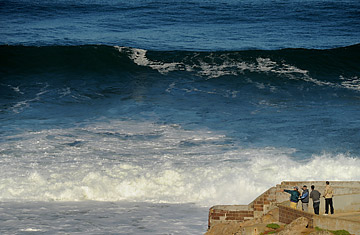
With a tsunami warning in effect for Northern California, sightseers watch waves off Ocean Beach in San Francisco, March 11th, 2011.
When a powerful earthquake in Japan unleashed a tsunami that sped across the northern Pacific, most people living along the beach in the coastal town of Santa Cruz, northern California, heeded evacuation warnings at 5:30 a.m. and drove up into the redwood hills for safety. Not Isaac Lee. He grabbed his surfboard and headed for the tsunami waves.
Isaac likes big waves, the bigger the better. "You weigh the dangers," says the burly, ginger-haired surfer. "I knew this wouldn't be an actual tidal wave. But you get a series of bigger swells." Zipping up his wet suit as he ran, Lee reached his favorite break, near the Big Dipper roller coaster on the Santa Cruz boardwalk, and saw that the tsunami had surged up the nearby river and was draining out, fast. The usually placid San Lorenzo river was raging. "I rode the surge out into the ocean, carrying me right up the face of the waves." The swells weren't enormous — Isaac had ridden 30 footers before at a notorious spot up the coast known as Mavericks — but the Japanese earthquake kicked up line after line of glassy eight-foot waves. "Phenomenal tube rides," he raved.
Less than a mile away from Isaac's surf break, the tsunami was wreaking some of its worst damage anywhere along the northwestern Pacific coast. It played havoc inside Santa Cruz's small yacht harbor, causing over $2 million in damage. "First the water drained out of the harbor, and all the boats settled to the bottom, leaning on their keels," says Linda Locklin, a Santa Cruz resident. "Then the water surged in, boats broke loose and started crashing into each other," she says. Meanwhile, outside the harbor the fierce tides caused a large whirlpool. "I'd never seen natural phenomena like this before," says Locklin, who had planned to go for an early morning row before she heard the tsunami warning. The outward surge dragged a few vessels into the ocean, where they bobbed in the roiling currents, while inside the harbor, boats careened like pin-balls, smashing into the docks, bridge pylons and into rows of sleek yachts.
The National Weather Service issued a tsunami warning for much of California, Washington and Oregon's coast following the massive 8.9-magnitude earthquake that struck off Japan's northeastern coast earlier today. Near the Klamath River, in northern California, a man was swept out to sea while photographing the incoming tidal surges, and a rescue operation is now underway to find and pull him from the seething currents. Inside Crescent City's harbor, local officials say that more than 35 vessels were damaged by the tidal surges.
Early this morning, thousands of people living in low-lying coastal areas of California were awoken by a telephone call from the National Weather Service warning that a tsunami was expected to hit. People were ordered to flee to higher ground. When the first tsunami waves from the mighty earthquake struck the California coast, at around 7:45 am, there was no giant wave. Instead, a series of violent tidal surges continued to batter the coastline throughout the morning, causing the water level in harbors to rise and fall 6 ft to 8 ft.. Locals praised the tsunami warning system and say it undoubtedly saved lives. Dan Haifley is Executive Director of O'Neil Sea Odyssey, which runs educational cruises for children aboard a 65 ft catamaran. If not for the warning, he says, ""We would've been out there in the harbor with a bunch of school kids when the tsunami hit."
